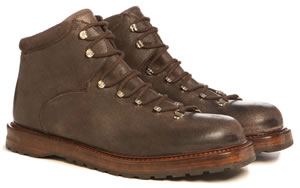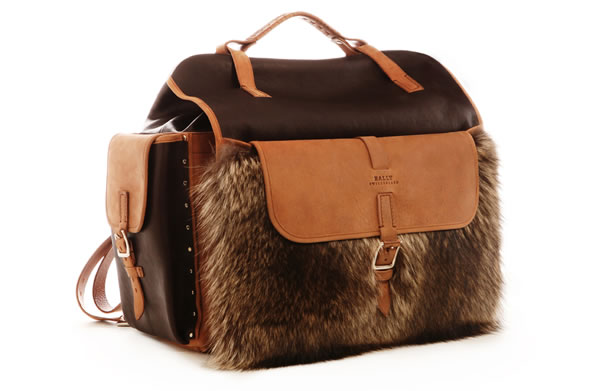 |  |
Boots from Bally’s new Everest capsule collection (left) are a modern version of the pair Sherpas wore to climb Everest (right) | |
Swiss luxury house Bally has begun a year-long celebration to mark the 60th anniversary of the historic first ascent of Mount Everest with an exclusive event during London Fashion Week on 7 January 2013.
When Sherpa Tenzing Norgay reached the summit on 29 May 1953 alongside Sir Edmund Hillary, he made that journey in a pair of Bally Reindeer-Himalaya boots.
Sixty years on, that pioneering spirit provided the inspiration for the brand’s Everest capsule collection recently revealed in London.
Items from the original Everest expeditions, including an official replica of the boots worn by Tenzing housed in the Bally archive, inspired the collection, which seeks to capture that trailblazing spirit, the company said.
Bally first designed mountaineering boots in the 1940s for the Swiss Foundation for Alpine Research which intended to explore the world’s unknown peaks. Bally footwear was supplied to various Swiss expeditions whose feedback allowed further development and improvements.
The boot worn by Tenzing was originally designed for climbing to a height of almost 7,000 metres. With its reindeer fur shell, separate inner and sturdy sole, the wearer’s feet were kept warm and protected even in extreme conditions.
Bally’s newly developed rubber sole was an important factor. For the first time, less metal was used close to the feet, which provided better insulation and less chance of frostbitten toes. A new hook lace-up system at the front made it easier for climbers to adjust their boots even under extreme conditions.
Key items in the new Everest capsule collection are three men’s boots based on traditional trekking and alpine styles. Each boot is constructed with a lightweight, injection moulded lug sole that is said to combine 2013 comfort and performance with the re-engineered 360-degree non-slip Bally grip, first patented by Bally in 1919. Double-stitch Norwegian construction aims to highlight the skill of Bally’s craftsmen.
The Vilmos boot is the centrepiece, inspired by Tenzing’s reindeer trekking boot and recreated in marmot fur lined with cashmere. Bally located the German manufacturer of the original hook lace-up system used on the original boots which was patented by Bally. The traditional hooks have been reproduced for the Vilmos, giving an authentic technical feel.
An official media presentation during Milan Men’s Autumn/Winter 13 Fashion Week will be followed by other celebratory events throughout the year, including a mobile exhibition in selected boutiques and department stores worldwide.
The in-store arrival of the collection’s signature pieces coincides with the 60th anniversary on 29 May, while Bally’s complete Everest capsule collection will be available from September 2013.
 |  |
Left: Bally Creative Directors Michael Herz and Graeme Fidler flank British actor Benedict Cumberbatch at the London launch event in January; Right: Bally’s Reindeer boots | |
About the Everest expedition
Until 1953, conquering Everest had remained a dream for mankind. Ever since Everest was first recognised as the world’s highest peak in 1852, mountaineers had dreamt of reaching the summit – but all had failed with lives lost in the process. Eventually a British team led by Officer John Hunt achieved the impossible, when two members of the group reached the summit on 29 May 1953: New Zealand mountaineer Sir Edmund Hillary and a Nepali Sherpa, Tenzing Norgay.
Hunt selected two climbing pairs to attempt to reach the summit, the first of which turned back 100 metres from the summit after running into oxygen problems. Two days later, the expedition made its second and final assault on the summit with the other climbing pair, Hillary and Tenzing.
Hillary had first attempted to climb Mount Everest in 1951 and again in 1952. This time, accompanied by Tenzing, the pair reached the summit at 11.30am local time on 29 May 1953.
Although Hillary and Tenzing were only on the summit for 15 minutes before they had to step off, those few minutes cemented their place in the history of man.
It was the important groundwork of Swiss expeditions in 1952 that helped the British team succeed where others had failed. Having climbed higher on the mountain than anyone before, the Swiss were able to provide vital information to other alpinists that proved invaluable in future attempts.
While accompanying the 1952 Swiss expedition, Tenzing was able to reach a height of about 8,595 metres on the southeast ridge, setting a new climbing altitude record for the time. Tenzing’s experience was useful when he was hired to be part of the British expedition the following year.
The legacy of those Swiss teams was an important factor in the British team’s success. Swiss mountaineers provided the local Sherpa community with Swiss-made equipment during their previous visits. It was not only Sherpa Tenzing Norgay who wore Bally’s Reindeer-Himalaya boots – all Sherpas on the 1953 expedition were equipped with the same technical Bally boots.
In late 1953, Tenzing travelled to Switzerland with his family where he visited the Swiss Alps as a guest of the Swiss Foundation for Alpine Research. Bally also presented Tenzing and his family with Bally shoes as a gift. When Bally asked whether he would allow the company to have the boots used during the ascent for its archive, Tenzing responded in a letter dated 1 November 1953 that he wanted to keep the boots since they reminded him of Switzerland and the earlier Swiss expeditions he had accompanied.
 |
This fur-trimmed bag forms part of Bally’s new Everest capsule collection |








